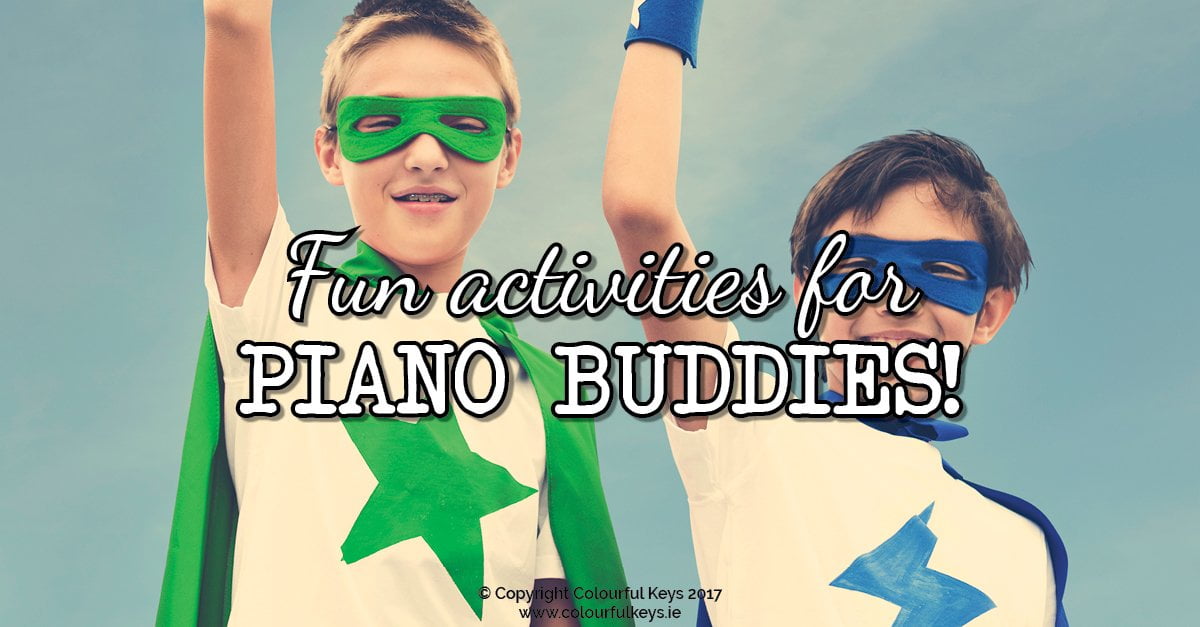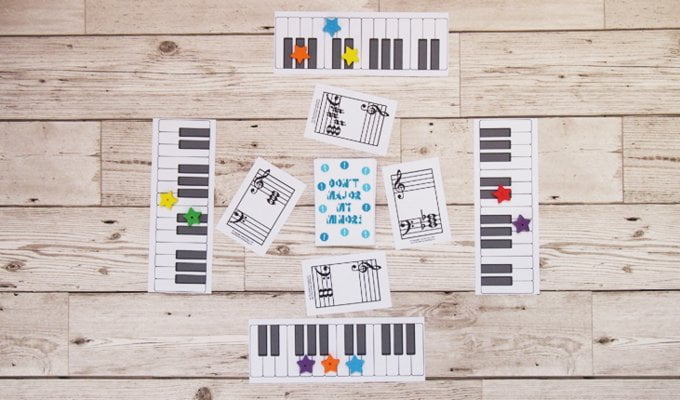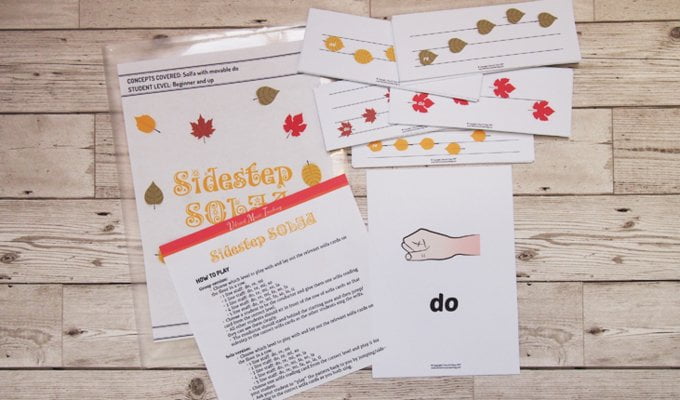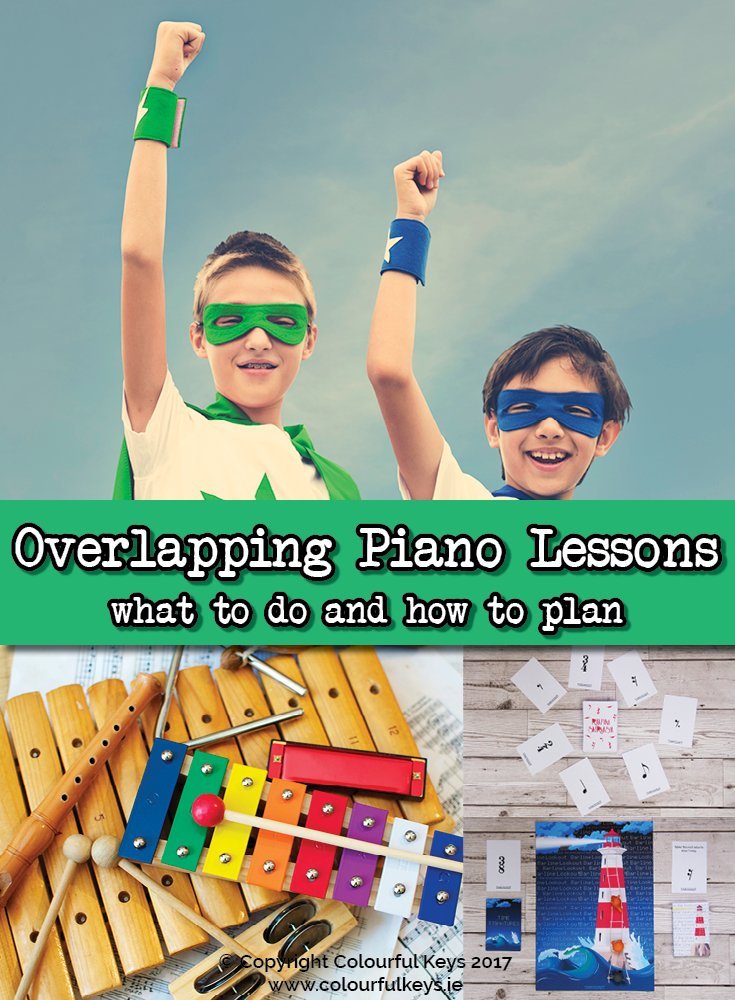A buddy piano lesson is what I call it when two students’ lesson times overlap in the middle, so that they get some time one on one, and some time together.

The specific durations of each segment are up to each teacher. In my studio I give two options:
- 40 minute buddy lessons: 20 minutes solo & 20 minutes buddy time
- 60 minute buddy lessons: 40 minutes solo & 20 minutes buddy time
The shorter buddy lessons are for my youngest students only. Most of my students are now in 60 minute buddy lessons – and I can’t tell you quite how much I love working this way.
I talked about buddy lessons on a recent webinar, and teachers were very exctied about it – and had tons of questions!
I’m going to be answering those questions in a series of posts on the topic – starting with this: what do we actually do during this “buddy piano lesson” time.
This post contains some affiliate links. Buying from one of these links does not cost you anything, but I do receive a small referral fee for sending you which goes towards the cost of running this site.
Duets
This one is pretty obvious. Perhaps it’s even your main motive for considering buddy piano lessons.
Playing duets is something I love to include in all my students’ lessons, and it’s so much easier when we have this overlapping time each and every week.
Of course we can play teacher duets with our students, and I still do that too, but student-student duets are a different flavour altogether.
When students play with us teachers – we tend to make it easy for them. They don’t need to be quite as diligent because we’ll cover their mistakes, catch up with them and improvise a little if necessary.
Another student will not do that. Both students need to listen carefully to make it work.

Subscribe to the newsletter and get the Ultimate Compendium of Buddy Lesson Activities
Enter your details to subscribe to the newsletter for piano teachers with information, tips and offers.
I hate spam as much as you do! I will only send you emails related directly to piano teaching and you can unsubscribe at any time.
Favourite Evenly-Levelled Duet Books
Chances are you’ll need tons of duet repertoire on hand if you’re going to try out buddy piano lessons. These are my top choices for beginner to intermediate piano students:
- Grand Duets for Piano by Melody Bober
- Famous & Fun Duets by Carol Matz
- Contest Winners for Two published by Alfred
There are tons of other options but if you get your hands on ever level of these series (over time as budget allows!) then you’ll be well set-up for most of your students.
Sight Reading Duets
For some of my piano students, I don’t actually want to add to their repertoire. Their practice time is limited as it is, and maybe learning a difficult duet isn’t our top priority right now.
That doesn’t mean they don’t play any duets in their buddy time. This is the perfect opportunity to include more sight reading.
Sight reading duets is something I want to do more and more with my students for several reasons:
- It’s more fun than reading dry sight reading exercises.
- It’s more time-efficient as two students are working on it at once.
- They really can’t stop or go back, they have to fudge through the mistakes and keep the train moving!
That last one is a biggie. It’s something I’m constantly trying to instill in students – and duets do it naturally. Almost by magic. 😉

Quick Study Duets
I like to include varied levels of repertoire, especially as my students advance. I aim to always have my students working on some quick studies (easy 1-2 week pieces), medium or at-level pieces, and maybe one bigger project.
For some students however that the quick studies are the first thing to get dropped from their practice. Now, if their quick studies are duets – that quickly becomes embarrassing.
Nothing like a bit of peer-pressure to encourage quick study practice.
Big Project Duets
Finally, you may have some students who would love to play a big, fancy duet for a concert or competition. Working on an ambitious project together is a fantastic way to bring your piano buddies together and create a sense of comradery.
If this is the case – I suggest taking some buddy time to explore duet options together before picking out a great piece. A website like Piano Pronto or Supersonics is amazing for this as you can listen to the music as you browse the site together.

Subscribe to the newsletter and get the Ultimate Compendium of Buddy Lesson Activities
Enter your details to subscribe to the newsletter for piano teachers with information, tips and offers.
I hate spam as much as you do! I will only send you emails related directly to piano teaching and you can unsubscribe at any time.
Duet Improvisations
I’ve been teaching all my piano buddies versions of the wonderful improvisation patterns from the Create First series by Forrest Kinney. Depending on the students’ levels, I have to adapt the accompaniment patterns and simplify but it’s pretty easy to do – and totally worth it.
Watch out for the upcoming quick clip where I’ll share an example of this in action. (That’ll be published in a few weeks. Make sure to subscribe to the blog so you’ll see it.)
Music Theory Games
It’s no surprise that music theory games makes this list. I love teaching kiddos through games. Heck, I even have a whole library dedicated to it!
My students in buddy lessons get to play games together every single week. They learn through laughter and experience music theory concepts away from the bench, and away from workbooks too.
In this video is just one example where we’re working on time signatures using a super fun, fast-paced card game.
(By the way, I share short teaching videos like this on blog every Thursday. Be sure to subscribe so you don’t miss any!)
If you’ve been looking to find more time for games in your piano lessons – buddy lessons are ideal for this. Even if you’re buddies are at different levels, it’s pretty easy to adapt games for the level gap using cheatsheets or more advanced flashcards.
Technical Drills
Yes, really. Buddy time is awesome for working on stuff that might usually be considered boring.
When you have two students together, it’s much easier to spice these things up a bit. 🙂
Scales
My favourite way to get buddy students to practice scales is using the Musiclock app on the iPad. This is essentially a backing track app – but it has a beautiful interface and lots of really cool tracks.
I let students take turns to turn this to a scale they both know and change the sound. Then they count in, and off they go!
Working on scales in this format is awesome because:
- Most students LOVE it.
- They get the chance to self-correct by looking at each other’s fingerings or technique.
- Weaker scales are quickly revealed without me having to say a word about it.
- They can give each other tips: “Remember this is the one that starts with 4th?”
- It feels genuinely musical because they are playing in time and listening properly.
This has actually been a huge time-saver during my solo lesson time with each student. When buddies are well-matched, I know I don’t have to review their scales – I wait ‘til their buddy arrives to do that.

Subscribe to the newsletter and get the Ultimate Compendium of Buddy Lesson Activities
Enter your details to subscribe to the newsletter for piano teachers with information, tips and offers.
I hate spam as much as you do! I will only send you emails related directly to piano teaching and you can unsubscribe at any time.
Chords
I’ve been making more of an effort to teach chords in a comprehensive way this year. I used to teach them more as necessary, but I’ve now resolved to get them fully under-hand before we need them.
The downside of this is that this means doing more drills…
But it’s actually been super fun! We’re using iReal Pro to work on chords in various patterns and progressions.
If you don’t know iReal Pro it’s basically an interactive chord chart that you can use to create a play various backing tracks. It’s very adaptable and I highly recommend it – although the interface does look a little intimidating at first. Listen to this podcast with the creator if you want to learn more.
These drills combined with some great chord and inversion games from the Vibrant Music Teaching library means that my tween students are fast becoming chord pros.

Can’t wait to put all this knowledge and skill to good use in our composing projects next semester!
Ear training
Over the past several years, I have been working to create more opportunities for aural work with my students – and to come up with a framework for developing these key skills.
However, like many teachers, I find this tough to fit in. I do a great job of bringing solfa singing and other Kodály inspired activities into my lessons…for a month or so…and then it fades out a bit.
There’s just so much to do!
This is where buddy lessons are, again, so much more efficient. Having this extra time with my students has made a huge impact on how often I do ear training with them, and also how well planned it is.

I can make these plans because I have the extra time. I know I’m going to be able to follow through.
Almost all ear training activities will work just as well with two students as with one. Here’s some ideas to get you thinking:
- Sing folk songs together and do singing games.
- Practice solfa with Kirwen hand signs using posters on the wall, or laid out on the floor.
- Play Solfa Sidestep, Aural Adventures (both from the Vibrant Music Teaching library) or other listening games.
- Play “do, re, mi” and then one of the three notes. Ask your students to identify which one it is.
- Signal a well-known song to your students using Kirwen signs – ask them if they recognise the song as they sing it.
- Work out a pop song by ear, as a team.
- Match contrasting sounds (high & low, major & minor, mi & so) to actions such as standing up and sitting down. Then get the wiggles out by playing tons of aural samples for your students to act out as quickly as they can!
I could go on and on with those but I hope that will get you started. Ear training activities are some of the easiest to adapt for two students.
Performance practice
Ready to dial up the teamwork and camaraderie?
Before any big performance, many of us get our students to do trial runs in the lessons. This way students get practice with the art of performing – and feel more prepared on the day.
Now, I do a pretty good job of being a pretend audience for these occasions. But a real audience is much better.

Piano buddies can be that audience for each other. They can provide helpful feedback (carefully nudged by the teacher) and give a confidence boost when it’s needed.
This not only helps with the performance, but it brings them closer together and gives them practice with being a good audience member too.
Download the Buddy Piano Lesson Cheatsheet
Enter your details and I’ll send you a cheatsheet so you can see all these great ideas at a glance.

Subscribe to the newsletter and get the Ultimate Compendium of Buddy Lesson Activities
Enter your details to subscribe to the newsletter for piano teachers with information, tips and offers.
I hate spam as much as you do! I will only send you emails related directly to piano teaching and you can unsubscribe at any time.
Have you tried a buddy piano lesson?
How did it go? Do you love it as much as I do?
Let me know your thoughts in the Vibrant Music Studio Teachers community on Facebook or in the comments below.

Love this idea! Actually started incorporating something similar for 2 boys that I have back to back and they are loving it. Do you have more information on how you charge for lessons like this?